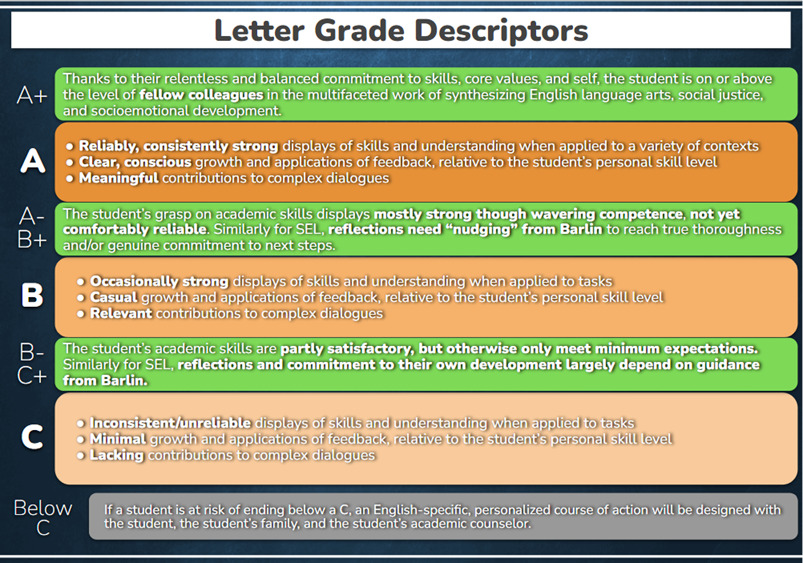As educators who focus on facilitating meaningful learning and genuine reflection, we are painfully familiar with the questions students often ask that demonstrate anything but:
- “How many points is this assignment worth?”
- “Do you offer any extra credit?”
- “Can you round up my grade?”
- “What do I need to do to get an A?”
These questions can deeply frustrate educators in pursuit of developing learners’ senses of intrinsic motivation—though personally, the moment that made me dramatically reorient my grading practices wasn’t such a question from a student but a student’s powerfully poignant reflection.
Three years ago, I facilitated a class dialogue to explore students’ thoughts on potential revisions to our grading system. In a moment of impressive vulnerability, a student named Hannah shared her takeaways from our literary journalism task: “You gave me the most loving and uplifting feedback I’ve ever received on my writing—but no matter how hard I tried, I couldn’t stop thinking about how I got a 47 out of 50, and not a perfect score.”
Hannah named a cognitive dissonance that so many students experience and with which many educators can empathize (Butler, 1987). The fundamental purpose of feedback is to guide learners toward growth—but educators and students alike know the feeling of when that guidance is obscured by points (or the lack thereof). We don’t want to perpetuate deleterious perfectionist tendencies, leading learners to believe that this illusory idea of “perfect” can even be quantified. Instead, we want learners to focus on becoming lifelong thinkers and doers for their own sake, not for the sake of more points.
So three years later, I’m here sharing with you the “why” behind the pedagogical shift to comments-only feedback that Hannah and other students led me to make—so that you can begin considering what the “how” can look like in your own practice.
What is comments-only feedback?
Coined by educator Sarah M. Zerwin (2020), “pointless” or comments-only feedback is an approach that eliminates numerical scoring from the assessment process, focusing solely on reflections, qualitative comments, and progress markers (e.g., “exceeded expectations,” “partial understanding”). The approach encapsulates feedback that is only qualitative; after all, when students receive both points and comments on tasks (such as with points-based rubrics), they tend to focus on the points. Once removed, points no longer distract learners, diminishing the cognitive dissonance that students like Hannah experience between numerical perfection and intrinsically motivated growth.
Zerwin also reminds us that comments-only feedback is the norm for settings where one isn’t a student: percentages, scores, and grades are rarely part of daily life after graduation; instead, qualitative insight from peers and mentors guides our growth as professionals.
To maintain a baseline “shared language” for tracing growth, this method trades points for scales. For examples, see Figure 1 for qualitative scales I designed to succinctly inform a learner of their proximity to course objectives, on a task overall or with discrete skills specifically; progress markers always came with an additional specific comment.

Instead of scoring a task as, say, 38 points out of 50, we offer an “applying” marker, providing the learner with a clearer sense of achievement and of subsequent next steps. By taking out the quantitative, we necessarily focus on the more meaningful qualitative.
Core advantages of comments-only feedback
In an educational culture that prioritizes numerical grading, educators and their students will understandably find comments-only feedback a bit awkward at first. Despite the initial challenges, if the primary aim of feedback is to empower learners to take realizable steps toward growth, investment in comments-only feedback yields an array of benefits:
- It streamlines educators’ communication and use of time. Instead of spending time justifying points and letters (e.g., “Why did I get a 7 out of 10?” “What does a B even mean?”), comments-only feedback directs the conversation with newfound clarity toward actionable next steps for how students can grow. From the moment students receive targeted and applicable feedback, without the distraction or quantitative translation of points, they have an immediate and unfiltered sense of how to improve. When given such self-reflective scaffolding in the form of clear and consistent feedback, learners no longer need their educators to hold their hands as tightly with extra office hours or detailed email exchanges defending grade determinations (Brookhart, 2017).
- It recognizes learners as fellow producers of knowledge. In a comments-only approach to feedback, the educator is positioned much more as a mentor and thought partner, and less so as a final arbiter of rubber-stamped scores. When creating quantitative scales to measure progress, it is crucial to include an “innovating” marker on your scale—or whatever term resonates most with you and your learners—to capture the fact that the educator’s expectations can be exceeded. This language and subsequent mindset decenters ideas of “perfection” or arbitrary “finish lines,” instead allowing us to codify within our grading systems an academic culture of collaboration, creativity, risk-taking, and imagination (Hattie & Timperley, 2007). (Students regularly and pleasantly surprised me in their goal-driven attempts to “innovate”!)
- It generates meaningful and individualized rigor. Comments-only feedback more precisely outlines what the most rigorous next steps are for any individual student, which is inevitably unique from what is most rigorous for other students in the class—a level of granularity that, say, two matching midterm scores would not necessarily capture (Tomlinson, 2014). By removing the pursuit of points or specific scores from students’ internal dialogues on how to improve, educators instead guide their students with feedback tailored to their respective needs and challenges. Even if that feedback comes from a collection of prewritten comments that address common areas of growth, as long as that feedback is precise and hand-picked, educators strategically differentiate how they encourage students to challenge themselves.
- It allows for gradual integration into grading systems. I know personally that despite the unique benefits of doing so, shifting your entire grading system exclusively to comments-only grading is considerably daunting and could very well be outside your bandwidth. Thankfully, even small integrations of comments-only feedback can recenter learners’ senses of clarity and intrinsic motivation. Class participation, quizzes, timed writes, lab reports, virtual forum posts: consider applying comments-only feedback structures to one or multiple of these course components. Even if other parts of the course remain points-based for now, students will carry what they gained from their comments-only feedback into those other assessments.
What about final letter grades?
Whether a course uses a hybrid of point-based and comments-only tasks or entirely commits to comments-only feedback, the final grade reflects a synthesis of student self-assessments, educator observations, and evidence of growth through performance tasks. Ideally, as with any grading system, how comments lead to final grades highly depends on the idiosyncrasies and evolving needs of educators and their students. My class opted for a portfolio system, evaluated according to letter grade descriptors that I cocreated with students, as shown in Figure 2. Students compiled their performance tasks, feedback, and self-reflections into portfolios; at the end of the semester, students and I individually conferenced to determine which letter grade descriptor best aligned with their portfolios.

There is no one right answer for how to synthesize qualitative observations into a summative grade. From basing grades on students’ end-of-course reflections to conferencing with students to reach consensus on a letter to simply assigning a letter justified by the educators’ holistic, comments-only feedback—there are many reasonable approaches that justify a final grade and scaffold students’ self-awareness.
Lingering questions about comments-only feedback
It would be ironic to claim that comments-only feedback, which attempts to dismantle perfectionism and ignite lifelong learning, is a perfect grading system. Merely considering a grading system outside conventional wisdom is, in and of itself, a perplexing yet worthwhile line of pedagogical inquiry:
- How does integrating comments-only systems as individual educators differ from team- or institution-based approaches?
- Which learning management systems and educational technologies can reflect a comments-only grading system?
- How much of the fundamental intention behind comments-only feedback is eventually foiled by final letter grades?
- Understanding that neither points-based nor comments-only feedback systems are entirely “objective,” where does “subjectivity” fit into the intrinsically subjective processes of growth and learning?
A case for comments-only is a case for discomfort
Especially given these complex and uncomfortable questions to which we are still, and always will be, developing answers, adhering to the norm of assigning points to tasks will likely feel comfortable and concrete. This system for assessment and reflection has been, for so many of us, all that we have experienced or perpetuated, so to stray from this norm is inherently unsettling.
But such discomfort is inherent to the experimentations, forward failings, and eventual progress necessary for redesigning paradigms that newly empower our students. A transition to comments-only feedback isn’t just a pedagogical shift: it’s a cultural one. Whether in our unique courses or across institutions, we as educators can foster cultures where learning is unambiguously a lifelong process, where failures become genuine opportunities—and where students like Hannah, who triggered this pedagogical shift in me in the first place, no longer have the fullness of their achievements obscured by points.
References
Brookhart, S. M. (2017). How to give effective feedback to your students. ASCD.
Butler, R. (1987). Task-involving and ego-involving properties of evaluation: Effects of different feedback conditions on motivational perceptions, interest, and performance. Journal of Educational Psychology, 79(4), 474–482. https://doi.org/10.1037//0022-0663.79.4.474
Hattie, J., & Timperley, H. (2007). The power of feedback. Review of Educational Research, 77(1), 81–112. https://doi.org/10.3102/003465430298487
Tomlinson, C. A. (2014). The differentiated classroom: Responding to the needs of all learners (2nd ed.). Pearson Education.
Zerwin, S. M. (2020). Point-less: An English teacher’s guide to more meaningful grading. Heinemann.
Aaron Barlin, MSEd, is a faculty member at the Rex and Margaret Fortune School of Education. He coaches both secondary and postsecondary educators on integrating social justice standards and social-emotional learning competencies. Outside Fortune, he consults with institutions and organizations around diversity, equity, and inclusion through “Emergent Change DEI.”






